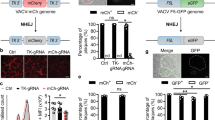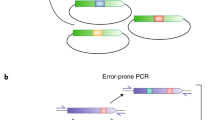Abstract
Genetic recombination is a major force driving the evolution of many viruses. Recombination between two copackaged retroviral genomes may occur at rates as high as 40% per replication cycle1. This enables genetic information to be shuffled rapidly, leading to recombinants with new patterns of mutations and phenotypes. The in vitro process of DNA shuffling2,3 (molecular breeding) mimics this mechanism on a vastly parallel and accelerated scale. Multiple homologous parental sequences are recombined in parallel, leading to a diverse library of complex recombinants from which desired improvements can be selected. Different proteins and enzymes have been improved using DNA shuffling4,5,6. We report here the first application of molecular breeding to viruses. A single round of shuffling envelope sequences from six murine leukaemia viruses (MLV) followed by selection yielded a chimaeric clone with a completely new tropism for Chinese Hamster Ovary (CHOK1) cells. The composition and properties of the selected clone indicated that this particular permutation of parental sequences cannot be readily attained by natural retroviral recombination. This example demonstrates that molecular breeding can enhance the inherently high evolutionary potential of retroviruses to obtain desired phenotypes. It can be an effective tool, when information is limited, to optimize viruses for gene therapy and vaccine applications when multiple complex functions must be simultaneously balanced.
This is a preview of subscription content, access via your institution
Access options
Subscribe to this journal
Receive 12 print issues and online access
$209.00 per year
only $17.42 per issue
Buy this article
- Purchase on Springer Link
- Instant access to full article PDF
Prices may be subject to local taxes which are calculated during checkout



Similar content being viewed by others
References
Hu, W.S. & Temin, H.M. Retroviral recombination and reverse transcription. Science 250, 1227– 1233 (1990).
Crameri, A., Raillard, S.-A., Bermudez, E. & Stemmer, W.P.C. DNA shuffling of a family of genes from diverse species accelerates directed evolution. Nature 391, 288– 291 (1998).
Stemmer, P.C. Rapid evolution of a protein in vitro by DNA shuffling. Nature 370, 389–391 ( 1994).
Patten, P.A., Howard, R.J. & Stemmer, W.P.C. Applications of DNA shuffling to pharmaceuticals and vaccines. Curr. Opin. Biotechnol. 8, 724–733 (1997).
Ness, J.E. et al. DNA Shuffling of subgenomic sequences of subtilisin. Nature Biotechnol. 17, 893–896 (1999).
Chang, C.C. et al. Evolution of a cytokine using DNA family shuffling. Nature Biotechnol. 17, 793–797 (1999).
Coffin, J.M. Genetic diversity and evolution of retroviruses. Curr. Top. Microbiol. Immunol. 176, 143–164 ( 1992).
Katz, R.A. & Skalka, A.M. Generation of diversity in retroviruses. Annu. Rev. Genet. 24, 409 –445 (1990).
Stanley, P. & Siminovitch, L. Complementation between mutants of CHO cells resistant to a variety of plant lectins. Somat. Cell Genet. 3, 391–405 (1977).
Deutschert, S.L. & Hirschberg, C.B. Mechanism of galactosylation in the golgi apparatus. J. Biol. Chem. 261, 96–100 (1996).
Miller, D.G. & Miller, D. Tunicamycin treatment of CHO cells abrogates multiple blocks to retrovirus infection, one of which is due to a secreted inhibitor. J. Virol. 66, 78–84 (1992).
Eiden, M.V., Farrell, K. & Wilson, C.A. Glycosylation dependent inactivation of the ecotropic murine leukemia virus receptor. J. Virol. 68, 626–631 (1994).
Wang, H. et al. Modulation of ecotropic murine retroviruses by N-linked glycosylation of cell surface receptor/amino acid transporter. J. Virol. 70, 6884–6891 (1996).
Masuda, M., Masuda, M., Hanson, C., Hoffman, P.M. & Ruscetti, S.K. Analysis of the unique hamster cell tropism of ecotropic Murine Leukemia Virus PVC-211. J. Virol. 70, 8534–8539 (1996).
Colicelli, J. & Goff, S.P. Sequence and spacing requirements of a retrovirus integration site. J. Mol. Biol. 199, 47–59 (1988).
Crameri, A., Whitehorn, E.A., Tate, E. & Stemmer, W.P.C. Improved Green Fluorescent Protein by molecular evolution using DNA shuffling . Nature Biotechnol. 14, 315– 319 (1996).
Acknowledgements
We thank J. Minshull, R. Shibata, P. Patten, O. Danos, F. Fan and J.Y. Han for useful input; S. Goff for the pNCA Moloney molecular clone; and Gene Therapy Laboratories for the G1 retroviral vector.
Author information
Authors and Affiliations
Corresponding author
Rights and permissions
About this article
Cite this article
Soong, NW., Nomura, L., Pekrun, K. et al. Molecular breeding of viruses. Nat Genet 25, 436–439 (2000). https://doi.org/10.1038/78132
Received:
Accepted:
Issue Date:
DOI: https://doi.org/10.1038/78132
This article is cited by
-
Creation of a cardiotropic adeno-associated virus: the story of viral directed evolution
Virology Journal (2013)
-
DNA Shuffling of Adeno-associated Virus Yields Functionally Diverse Viral Progeny
Molecular Therapy (2008)
-
Revealing biases inherent in recombination protocols
BMC Biotechnology (2007)
-
Engineering targeted viral vectors for gene therapy
Nature Reviews Genetics (2007)
-
AAV does the shuffle
Nature Biotechnology (2006)



